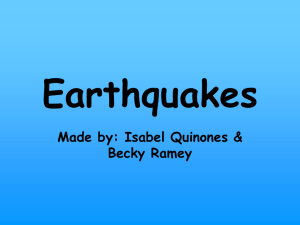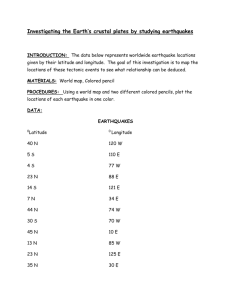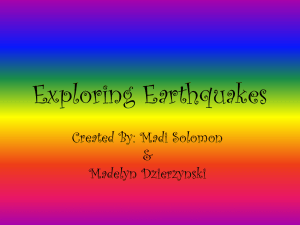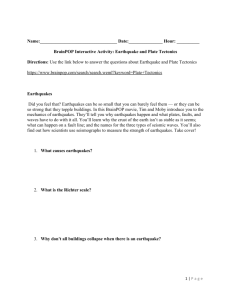Essential Questions
advertisement
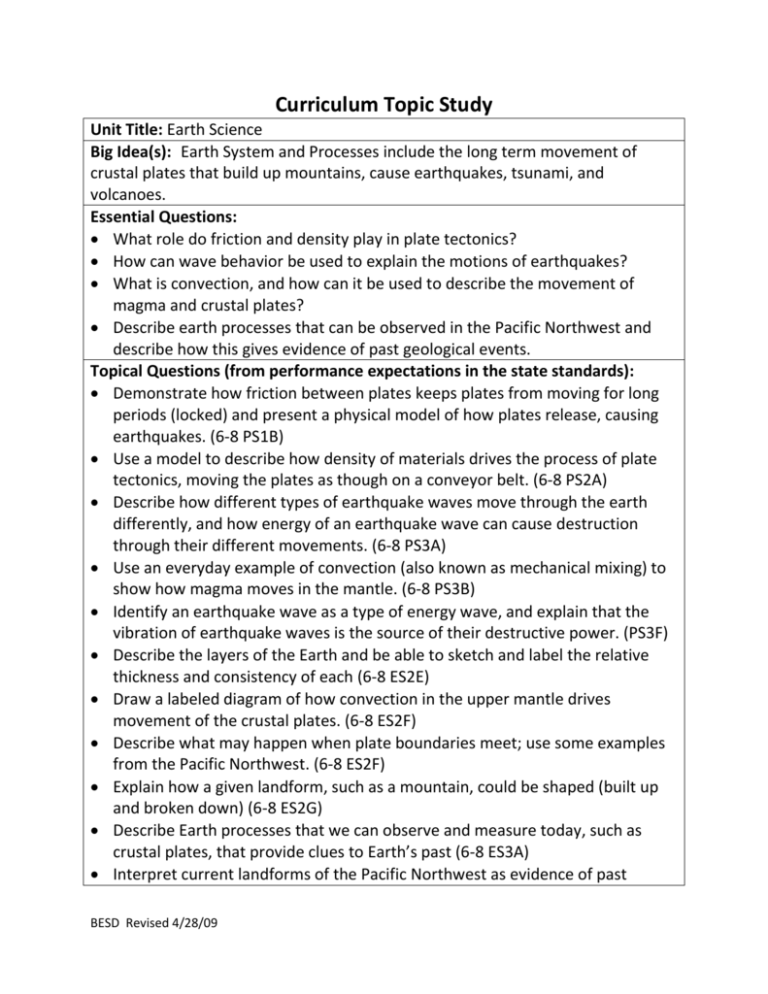
Curriculum Topic Study Unit Title: Earth Science Big Idea(s): Earth System and Processes include the long term movement of crustal plates that build up mountains, cause earthquakes, tsunami, and volcanoes. Essential Questions: What role do friction and density play in plate tectonics? How can wave behavior be used to explain the motions of earthquakes? What is convection, and how can it be used to describe the movement of magma and crustal plates? Describe earth processes that can be observed in the Pacific Northwest and describe how this gives evidence of past geological events. Topical Questions (from performance expectations in the state standards): Demonstrate how friction between plates keeps plates from moving for long periods (locked) and present a physical model of how plates release, causing earthquakes. (6-8 PS1B) Use a model to describe how density of materials drives the process of plate tectonics, moving the plates as though on a conveyor belt. (6-8 PS2A) Describe how different types of earthquake waves move through the earth differently, and how energy of an earthquake wave can cause destruction through their different movements. (6-8 PS3A) Use an everyday example of convection (also known as mechanical mixing) to show how magma moves in the mantle. (6-8 PS3B) Identify an earthquake wave as a type of energy wave, and explain that the vibration of earthquake waves is the source of their destructive power. (PS3F) Describe the layers of the Earth and be able to sketch and label the relative thickness and consistency of each (6-8 ES2E) Draw a labeled diagram of how convection in the upper mantle drives movement of the crustal plates. (6-8 ES2F) Describe what may happen when plate boundaries meet; use some examples from the Pacific Northwest. (6-8 ES2F) Explain how a given landform, such as a mountain, could be shaped (built up and broken down) (6-8 ES2G) Describe Earth processes that we can observe and measure today, such as crustal plates, that provide clues to Earth’s past (6-8 ES3A) Interpret current landforms of the Pacific Northwest as evidence of past BESD Revised 4/28/09 geological events (6-8 ES3D) Describe how crustal plate movement can change the nonliving factors in an ecosystem and identify how scientists examine what happens over time to nonliving factors using current geologic formations and fossils. (LS2D) Common Misconceptions: Students often believe that the world was always as it is now Density is often confused with weight (how “heavy” something is, vs. “heavy for its size”) Many children think that all mountains are volcanoes Many children think of all rocks as coming from a volcano, regardless of whether they are sedimentary, metamorphic, or igneous. Children often think that a random, unspecific buildup of heat and pressure ONLY is what is responsible for mountain-building, and do not grasp the connection to plate tectonics. Children often misunderstand the topic of heat and heat transfer, flow, and think of “cold” as a substance rather than an absence of heat energy. Many students do not recognize friction as a force (many see a force only as “getting things going” rather than stopping things, and see friction as a directionless resistance to motion distinct from a force opposed to motion). Many students believe that changes are sudden (geologic time scale is difficult to grasp) Student often cannot explain the causes of volcanoes and earthquakes Pre-existing understandings: Processes that Shape the Earth: Some changes are slow and some are fast Change is something that happens to many things Chunks of rock come in many shapes and sizes (sand to boulders) How fast things move differs greatly Things change in a steady, repetitive, or irregular ways Waves, wind, water, and ice shape and re-shape the earth Things on or near the earth are pulled toward it by earth’s gravity Rock is composed of different minerals (smaller rocks come from weathering and breakage) Plate tectonics: There are a variety of different landforms on the earth’s surface Critical Thinking Skill focus (meta-cognition skills): Note booking questions, ways they understand, and how they came to their new knowledge. Hmm, Duh, Aha! sheet could be used for metacognitive checks or exit slips/warm-ups Essential questions can be answered at the end of each chapter or unit as a mini-quiz or formative assessment or topical questions (performance expectations from standards) to guide thinking and use as notebook questions. Probes found/developed to uncover student misconceptions (Keeley, etc) *Mountaintop fossil, Keeley “Uncovering” volume 2 BESD Revised 4/28/09 Necessary skills, facts, and processes needed (focused on in this unit/kit): Modeling (making and interpreting) Measurement of properties (density) Inquiry and the scientific method— *predicting what will happen *conducting experiments *drawing conclusions from a specific circumstance Drawing labeled diagrams of phenomena Comparing and Contrasting Observing and describing processes that happen in the world Vocabulary: Earthquake, map legend, stored (potential) energy, earthquake waves (seismic waves), fault, creep, focus, epicenter, crust, lithosphere, mantle, outer core, inner core, tectonic plates, convection current, diameter, magma, divergent plate boundary, lateral (transform) plate boundary, convergent plate boundary, volcano, mountain, plain, plateau, continental slope, abyssal plain, underwater delta, turbidity current, wave amplitude, earthquake intensity, earthquake magnitude, seismograph, seismogram, surface waves, body waves, P- (primary) waves, S- (secondary) waves, expansion, compression, isoseismal, tsunami, mountain range WA State Standards for grades 6-8 covered PS1B, PS2A, PS3A, PS3B, PS3F, ES2E, ES2F, ES2G, ES3A, ES3D, LS2D (on attached matrix sheet) Formative Assessments: *probes *essential questions as “quizzes” *topical questions as exit slips or warm-ups Summative Assessment: Needs to be developed Assessment types and possible questions: *Challenge students to design/build their own seismograph after using the one in the materials *Challenge students to design an earthquake-proof structure (spaghetti tower?) *Have students design a flow chart of processes that are involved in plate tectonics *Have students do a research project on a major local geologic/natural catastrophe (earthquake, volcano, or tsunami) *Have students design models of the different topics (plate tectonics, layers of the earth, continental drift) Pre-Test(s) Should be developed in conjunction with the summative assessment(s). BESD Revised 4/28/09 Investigation Pacing (investigation numbers and number weeks): Introduction: 1-2 days (1-2, 50-minute periods) Unit I: Defining an Earthquake *Energy waves cause Earthquakes: About 1 ½ weeks (8, 50-minute periods). -Activities: 1: A wet wave experience, 2: It’s your fault, 3: Visual vocabulary, 4: Local legends Unit II: Why and Where Earthquakes occur *Plates going places (grades 3-4 unit): About 1 week (5-6, 50-minute periods). Do only if students need remediation or have insufficient background. -Activities: 1: What’s Inside, 2: We’re all cracked up, 3: Plates of the earth, 4: Hot stuff rises and cold stuff sinks. *Layers, Plates, and Quakes: About 1 week (5-6, 50-minute periods) Activities: 1: Crust to core: a pizza the earth, 2: Busy boundaries, 3: Slide, collide, and separate, 4: The history of geography Unit III: Physical Results of Earthquakes *Building up and breaking down: About 1 week (5-6, 50-minute periods) -Activities: 1: Mountain, plain, and plateau, 2: The folding mountains mystery, 3: Mountain molding, 4: Underwater avalanche Unit IV: Measuring Earthquakes *Sizing up Earthquake waves: About 1 week (5-6, 50-minute periods) -Activities: 1: Popping P-waves, 2: The S-wave machine, 3: Traveling tremors, 4: Set up a seismograph Unit V: Recognizing an Earthquake *Quake events range far and wide: About 1 week (5-6, 50-minute periods) -Activities: 1: Quake events, 2: Earthquakes are expensive, 3: Sizing up isoseimals, 4: Tsunami! Notes on Remediation and Acceleration: Remediation: An extra week can be spent in unit II doing the grades 3-4 activities if necessary. Acceleration: Two of the activities could be cut out of Unit V if the teacher thought it necessary or appropriate. Extension: Students could complete a project in conjunction with this unit, either as an at-home research project, or as an in-class project such as building spaghetti towers that are earthquake-resistant. BESD Revised 4/28/09


